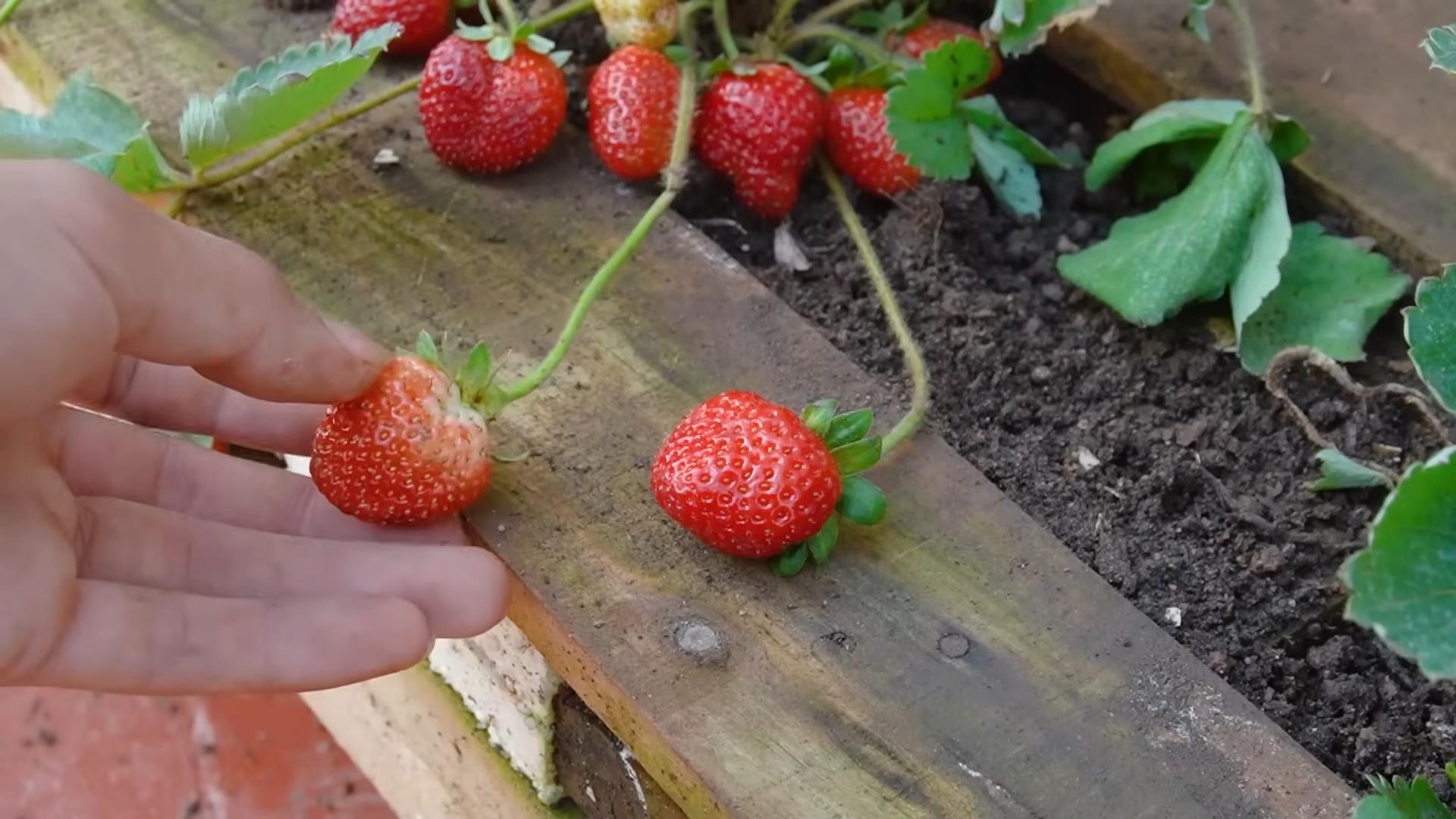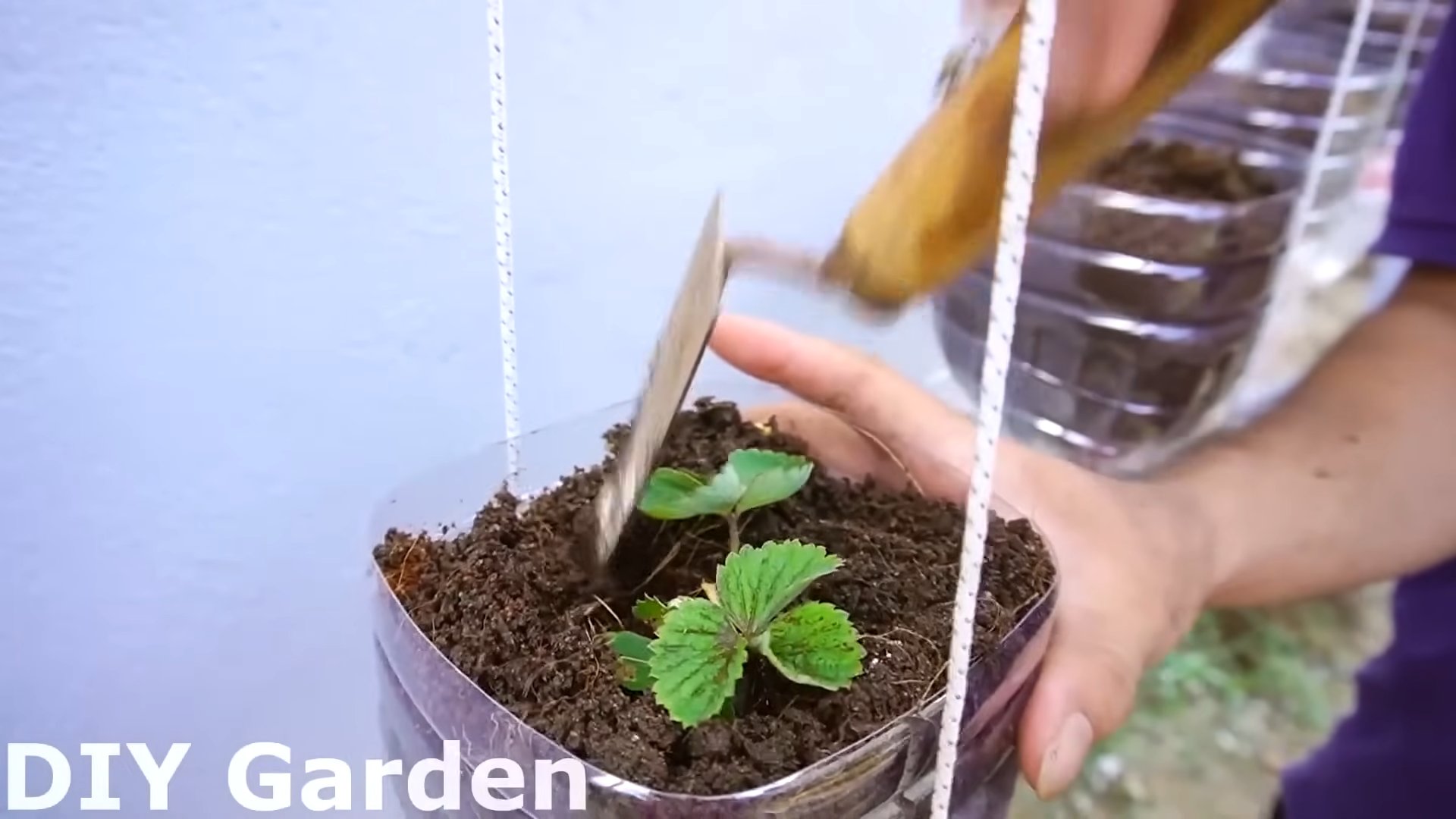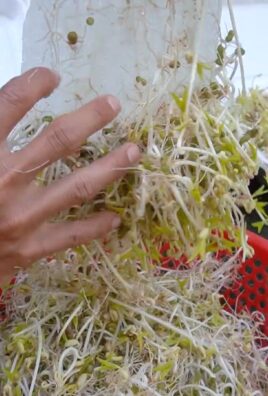Grow Strawberries at Home – imagine plucking juicy, sun-ripened strawberries straight from your own garden! It’s a dream many of us share, and it’s more achievable than you might think. For centuries, strawberries have been cherished not only for their delicious flavor but also for their vibrant color and nutritional benefits. From ancient Roman gardens to medieval monastery plots, these little red gems have held a special place in our hearts and diets.
But let’s face it, buying strawberries from the store can be disappointing. Often, they lack that intense sweetness and aroma that makes a strawberry truly special. That’s where the magic of home gardening comes in! This DIY guide is packed with simple, effective tricks and hacks to help you successfully grow strawberries at home, even if you have limited space or gardening experience. I’m going to show you how to avoid common pitfalls, maximize your yield, and enjoy a bountiful harvest of sweet, organic strawberries all season long. Get ready to transform your backyard, balcony, or even a sunny windowsill into a strawberry paradise!

Grow Your Own Delicious Strawberries: A DIY Guide
Hey there, fellow gardening enthusiasts! I’m so excited to share my tried-and-true method for growing plump, juicy strawberries right in your own backyard (or even on your balcony!). Forget those bland, store-bought berries – nothing beats the flavor of homegrown strawberries, and trust me, it’s easier than you think.
What You’ll Need: The Strawberry Starter Pack
Before we dive in, let’s gather our supplies. Here’s a list of everything you’ll need to get started:
* Strawberry Plants: This is the most important part! You can choose from different varieties like June-bearing, everbearing, or day-neutral. I personally love everbearing varieties because they produce fruit throughout the growing season. You can buy bare-root plants or potted plants from your local nursery.
* Potting Mix: A well-draining potting mix is crucial for healthy strawberry growth. Avoid using garden soil, as it can become compacted and doesn’t provide adequate drainage.
* Containers (Optional): If you’re short on space or prefer container gardening, you’ll need pots or hanging baskets. Make sure they have drainage holes!
* Gardening Gloves: Protect your hands from dirt and potential irritants.
* Trowel or Small Shovel: For planting and transplanting.
* Watering Can or Hose: To keep your strawberry plants hydrated.
* Fertilizer: A balanced fertilizer formulated for fruits and vegetables will help your plants thrive. I recommend a fertilizer with an NPK ratio of 10-10-10 or something similar.
* Mulch: Straw mulch is ideal for strawberries, as it helps retain moisture, suppress weeds, and keep the berries clean.
* Bird Netting (Optional): If you live in an area with a lot of birds, you might want to protect your precious berries with netting.
* Pruning Shears or Scissors: For trimming runners and dead leaves.
Choosing the Right Strawberry Variety
Okay, so you’re ready to buy your plants. But which ones should you choose? Here’s a quick rundown of the different types:
* June-Bearing Strawberries: These produce a large crop of berries in the spring, usually around June (hence the name!). They’re a good choice if you want a big harvest all at once.
* Everbearing Strawberries: These produce two or three smaller crops of berries throughout the growing season. I find them to be a great option for continuous snacking!
* Day-Neutral Strawberries: These are similar to everbearing varieties, but they’re less sensitive to day length, meaning they can produce fruit even in the fall.
Consider your climate and personal preferences when choosing a variety. Your local nursery can also provide recommendations based on your specific area.
Planting Your Strawberry Plants: Getting Started
Now for the fun part: planting! Whether you’re planting in the ground or in containers, the process is pretty much the same.
1. Prepare the Soil: If you’re planting in the ground, choose a sunny spot with well-drained soil. Amend the soil with compost or other organic matter to improve its fertility and drainage. If you’re using containers, fill them with your chosen potting mix.
2. Dig the Holes: Dig holes that are large enough to accommodate the root ball of your strawberry plants. Space the holes about 12-18 inches apart if planting in the ground, or one plant per container.
3. Plant the Strawberries: Gently remove the strawberry plants from their containers or packaging. If you’re using bare-root plants, soak the roots in water for about 30 minutes before planting. Place the plants in the holes, making sure the crown (the point where the roots meet the stem) is level with the soil surface. Don’t bury the crown, as this can cause the plant to rot.
4. Backfill and Water: Backfill the holes with soil, gently firming it around the plants. Water thoroughly to settle the soil and provide moisture to the roots.
5. Mulch: Apply a layer of straw mulch around the plants to help retain moisture, suppress weeds, and keep the berries clean.
Caring for Your Strawberry Plants: Keeping Them Happy
Once your strawberry plants are planted, it’s important to provide them with proper care to ensure a bountiful harvest.
1. Watering: Water your strawberry plants regularly, especially during dry periods. Aim to keep the soil consistently moist, but not waterlogged. Water deeply at the base of the plants, avoiding wetting the foliage, as this can promote fungal diseases.
2. Fertilizing: Fertilize your strawberry plants every 2-3 weeks with a balanced fertilizer. Follow the instructions on the fertilizer packaging for proper application rates.
3. Weeding: Keep your strawberry patch free of weeds, as they can compete with your plants for nutrients and water. Hand-pull weeds regularly or use a hoe to cultivate the soil.
4. Pruning: Strawberry plants produce runners, which are long stems that grow horizontally and develop new plantlets. If you want to maximize fruit production, it’s best to prune off the runners, as they can divert energy away from fruit development. Use pruning shears or scissors to cut the runners close to the main plant.
5. Pest and Disease Control: Keep an eye out for pests and diseases that can affect strawberry plants. Common pests include aphids, spider mites, and slugs. Common diseases include gray mold and leaf spot. If you notice any problems, take action promptly to prevent them from spreading. You can use organic pest control methods or fungicides if necessary.
6. Protecting from Birds: Birds love strawberries just as much as we do! If you’re having trouble with birds eating your berries, you can protect them with bird netting. Drape the netting over your plants, making sure to secure it to the ground to prevent birds from getting underneath.
Harvesting Your Strawberries: The Sweet Reward
After all your hard work, it’s finally time to harvest your strawberries!
1. When to Harvest: Strawberries are ready to harvest when they’re fully red and slightly soft to the touch. They should also detach easily from the plant.
2. How to Harvest: Gently grasp the strawberry near the stem and twist or snip it off the plant. Avoid pulling on the berry, as this can damage the plant.
3. Enjoy Your Harvest: Eat your strawberries fresh, use them in desserts, or preserve them for later. They’re delicious in jams, pies, and smoothies.
Overwintering Your Strawberry Plants: Preparing for Next Year
If you live in an area with cold winters, you’ll need to protect your strawberry plants from freezing temperatures.
1. Mulch Heavily: Apply a thick layer of straw mulch around your plants to insulate them from the cold.
2. Water Before Freezing: Water your plants thoroughly before the ground freezes to help prevent dehydration.
3. Cover with a Blanket (Optional): If you’re expecting extremely cold temperatures, you can cover your plants with a blanket or tarp for extra protection.
4. Remove Mulch in Spring: In the spring, remove the mulch gradually as the weather warms up.
Troubleshooting Common Strawberry Problems
Even with the best care, you might encounter some problems while growing strawberries. Here are a few common issues and how to address them:
* Small Berries: This can be caused by a lack of nutrients, water, or sunlight. Make sure your plants are getting enough of all three.
* Rotting Berries: This is often caused by fungal diseases, such as gray mold. Improve air circulation around your plants and avoid wetting the foliage when watering.
* Pests: Inspect your plants regularly for pests and take action promptly if you find any.
* No Berries: This can be caused by a lack of pollination. Make sure your plants are getting enough sunlight and attract pollinators to your garden by planting flowers.
Growing Strawberries in Containers: A Great Option for Small Spaces
If you don’t have a lot of space, you can still grow strawberries in containers. Here are a few tips for container gardening:
* Choose the Right Container: Select a container that is at least 12 inches in diameter and has drainage holes.
* Use a Well-Draining Potting Mix: Avoid using garden soil, as it can become compacted and doesn’t provide adequate drainage.
* Water Regularly: Container plants tend to dry out more quickly than plants in the ground, so water them regularly.
* Fertilize Regularly: Container plants also need to be fertilized more frequently than plants in the ground.
* Choose a Sunny Location: Place your containers in a sunny spot that gets at least 6 hours of sunlight per day.
Propagating Strawberries: Expanding Your Patch
Once you have a thriving strawberry patch, you can

Conclusion
So, there you have it! Growing strawberries at home is not only achievable, but it’s also incredibly rewarding. Forget those bland, store-bought berries that lack the vibrant sweetness of a sun-ripened strawberry. With a little effort and the right approach, you can cultivate a thriving strawberry patch right in your own backyard, balcony, or even windowsill.
This DIY method, focusing on [mention specific method from article, e.g., vertical planters, raised beds, container gardening], offers a fantastic solution for maximizing space and ensuring optimal growing conditions. It’s a game-changer for urban gardeners and anyone looking to enjoy fresh, delicious strawberries without the hassle of large-scale farming.
Why is this a must-try? Because it puts you in control. You choose the variety of strawberry that tantalizes your taste buds, you control the soil quality, and you dictate the amount of sunlight your plants receive. This translates to strawberries that are bursting with flavor, packed with nutrients, and free from harmful pesticides. Plus, there’s an undeniable satisfaction in harvesting your own food, knowing you nurtured it from a tiny plant to a bountiful source of sweetness.
Looking to personalize your strawberry-growing experience? Consider these variations:
* Experiment with different strawberry varieties: From everbearing to June-bearing, each type offers a unique flavor profile and fruiting schedule. Try a mix to extend your harvest season.
* Incorporate companion plants: Basil, thyme, and marigolds are excellent companions for strawberries, helping to deter pests and improve growth.
* Get creative with your containers: Use repurposed materials like old tires, wooden pallets, or even hanging baskets to create a unique and visually appealing strawberry garden.
* Try hydroponics: For a more advanced approach, explore hydroponic strawberry growing for faster growth and higher yields.
* Protect your plants: Use netting to protect your ripening berries from birds and other critters.
Don’t be intimidated if you’re a beginner. Growing strawberries at home is a forgiving process, and even small successes are incredibly rewarding. The key is to start small, be patient, and learn from your experiences.
We wholeheartedly encourage you to give this DIY trick a try. Imagine the joy of picking your own fresh strawberries for breakfast, adding them to smoothies, or baking them into delicious desserts. It’s a simple pleasure that can bring a touch of sunshine to your everyday life.
Once you’ve embarked on your strawberry-growing adventure, we’d love to hear about your experience! Share your photos, tips, and challenges in the comments below. Let’s create a community of strawberry enthusiasts and inspire others to discover the joys of growing their own food. Let us know what kind of strawberry growing method worked best for you!
Frequently Asked Questions (FAQ)
Q: What is the best time of year to plant strawberries?
A: The best time to plant strawberries depends on your climate and the type of strawberry you’re growing. Generally, early spring or late fall are ideal. In colder climates, spring planting allows the plants to establish themselves before winter. In warmer climates, fall planting gives them a head start on the growing season. June-bearing strawberries are typically planted in early spring, while everbearing and day-neutral varieties can be planted in either spring or fall. Check your local climate guidelines for the most accurate planting times.
Q: What kind of soil do strawberries need?
A: Strawberries thrive in well-drained, slightly acidic soil with a pH between 5.5 and 6.5. Amend your soil with compost or other organic matter to improve drainage and fertility. Avoid heavy clay soils, as they can retain too much moisture and lead to root rot. If you’re growing in containers, use a high-quality potting mix specifically formulated for fruits and vegetables.
Q: How much sunlight do strawberries need?
A: Strawberries need at least 6-8 hours of direct sunlight per day to produce a good crop of fruit. Choose a location that receives plenty of sunlight throughout the growing season. If you’re growing in containers, you can move them around to ensure they get enough sun.
Q: How often should I water my strawberry plants?
A: Water your strawberry plants regularly, especially during dry periods. Aim to keep the soil consistently moist but not waterlogged. Water deeply at the base of the plants, avoiding wetting the foliage, which can promote fungal diseases. Check the soil moisture regularly and adjust your watering schedule accordingly. Container-grown strawberries may need more frequent watering than those grown in the ground.
Q: How do I fertilize my strawberry plants?
A: Fertilize your strawberry plants in early spring and again after the first harvest. Use a balanced fertilizer specifically formulated for fruits and vegetables. Follow the instructions on the fertilizer package carefully. Avoid over-fertilizing, as this can lead to excessive foliage growth and reduced fruit production. Organic options like compost tea or fish emulsion are also excellent choices.
Q: How do I protect my strawberries from pests and diseases?
A: Monitor your strawberry plants regularly for signs of pests and diseases. Common pests include aphids, spider mites, and slugs. Control pests with insecticidal soap, neem oil, or handpicking. Prevent fungal diseases by ensuring good air circulation, avoiding overhead watering, and removing any diseased foliage promptly. Bird netting is essential to protect your ripening berries from hungry birds.
Q: How do I prune my strawberry plants?
A: Pruning is important for maintaining healthy strawberry plants and maximizing fruit production. Remove runners (the long stems that grow out from the main plant) from June-bearing strawberries to encourage the plants to focus their energy on fruit production. Everbearing and day-neutral strawberries can produce fruit on runners, so you can leave some runners if you want to propagate new plants. Remove any dead or diseased foliage regularly.
Q: When will my strawberry plants start producing fruit?
A: The time it takes for strawberry plants to start producing fruit depends on the variety and the growing conditions. June-bearing strawberries typically produce fruit in their second year. Everbearing and day-neutral varieties can produce fruit in their first year, although the harvest may be smaller. Be patient and provide your plants with the care they need, and you’ll be rewarded with a delicious harvest.
Q: How do I harvest strawberries?
A: Harvest strawberries when they are fully ripe and red all over. Gently twist the berry off the plant, leaving the green cap and a short stem attached. Handle the berries carefully to avoid bruising them. Harvest in the morning when the berries are cool and firm. Store harvested strawberries in the refrigerator for up to a week.
Q: Can I grow strawberries in containers?
A: Absolutely! Growing strawberries in containers is a great option for those with limited space. Choose a container that is at least 12 inches in diameter and has good drainage. Use a high-quality potting mix and provide your plants with plenty of sunlight and water. Container-grown strawberries may need more frequent watering and fertilizing than those grown in the ground.
Q: What are some common problems when growing strawberries and how can I fix them?
A: Some common problems include:
* Lack of fruit: Ensure adequate sunlight, proper fertilization, and pollination.
* Small berries: Provide sufficient water and nutrients. Thin out the plants if they are overcrowded.
* Rotting fruit: Improve air circulation and avoid overhead watering. Remove any diseased fruit promptly.
* Pest infestations: Use appropriate pest control methods, such as insecticidal soap or neem oil.
By addressing these issues promptly, you can ensure a healthy and productive strawberry patch.





Leave a Comment